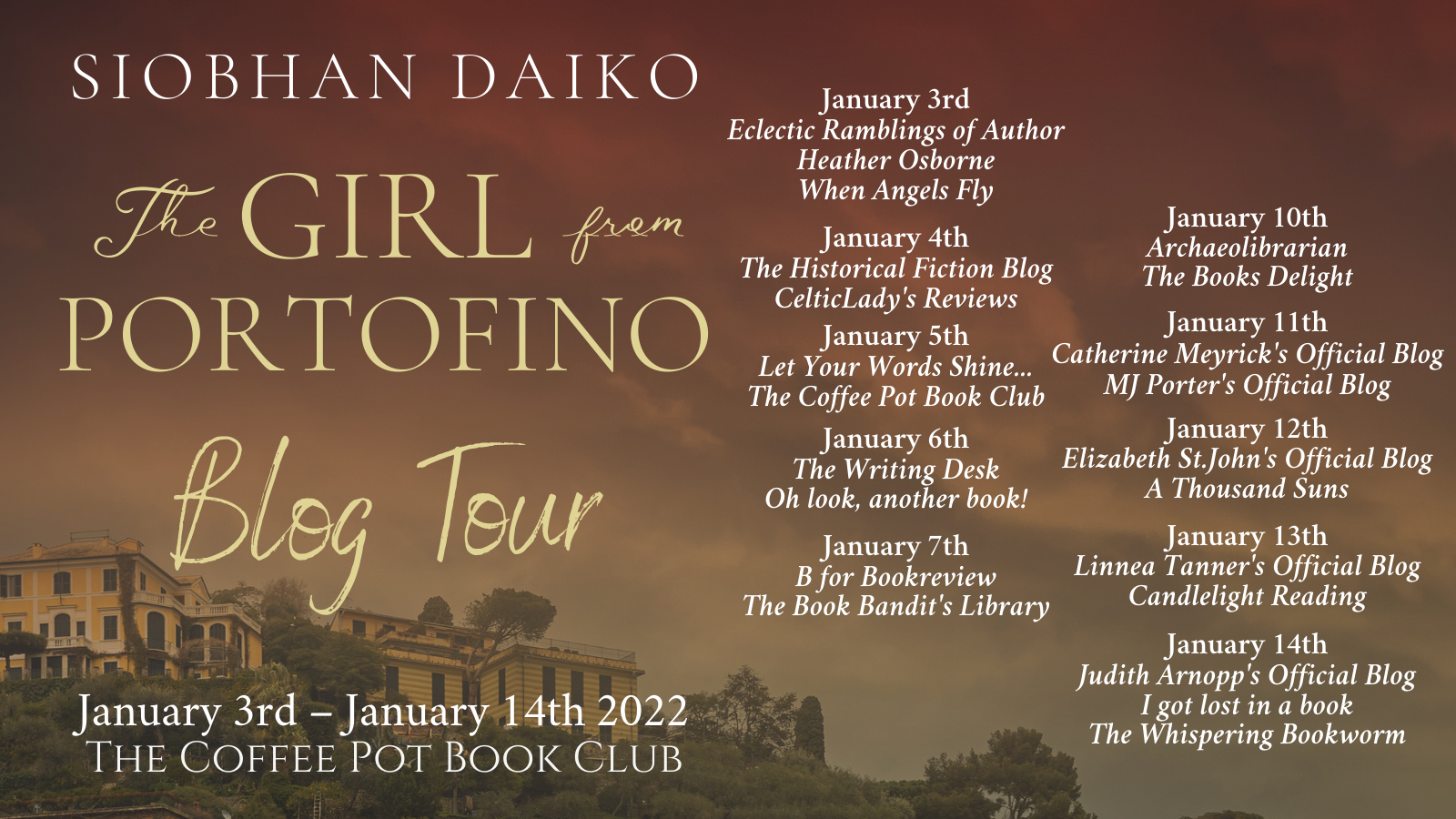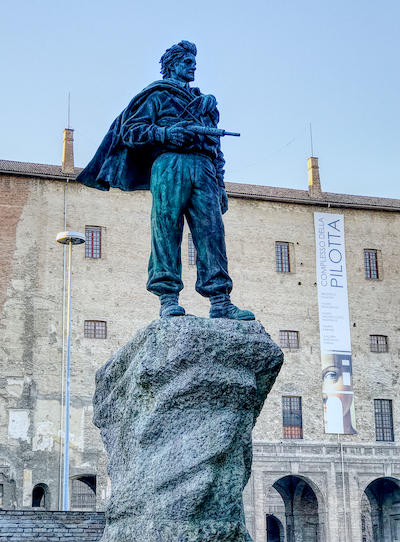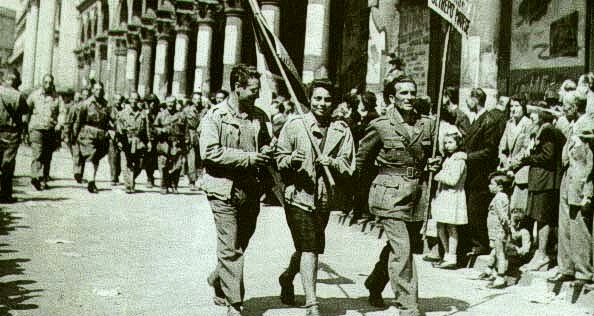
12 Jan Siobhan Daiko The Girl from Portofino Coffee Pot Book Club Blog Tour #HistoricalFiction #WomensFiction #WorldWarIIRomance #WomensHistoricalFiction #ItalianHistorical #HistoricalRomance #CoffeePotBookClub #BlogTour @siobhandaiko @maryanneyarde
FEATURED AUTHOR: DIOBHAN DAIKO
To start out the new year of 2022, it is my pleasure to introduce Siobhan Daiko as part of The Coffee Pot Book Club Blog Tour being held between January 3th – January 14th, 2022. Siobhan Daiko is the author of the Women’s Historical Fiction/20th Century Historical/World War 2 Historical Fiction, The Girl from Portofino (Girls of the Italian Resistance: A collection of standalone novels set in Italy during World War 2), which was released by Asolando Books on 30th December 2021 (300 pages).
One of the questions I had is what significance did the Italian resistance have in the outcome of World War II. Below is an enlightening post by Author Daiko entitled, “Significance of the Italian Resistance in World War 2,” which answers my question. Also below are highlights of The Girl from Portofino and Siobhan Daiko’s biography.

For information on the complete tour, CLICK Tour Schedule Page
HIGHLIGHTS: THE GIRL FROM PORTOFINO

The Girl from Portofino
(Girls of the Italian Resistance: A collection of standalone novels set in Italy during World War 2)
By Siobhan Daiko
In 1970 Gina Bianchi returns to Portofino to attend her father’s funeral, accompanied by her troubled twenty-four-year-old daughter, Hope. There, Gina is beset by vivid memories of World War 2, a time when she fought with the Italian Resistance and her twin sister, Adele, worked for the Germans.
In her childhood bedroom, Gina reads Adele’s diary, left behind during the war. As Gina learns the devastating truth about her sister, she’s compelled to face the harsh brutality of her own past. Will she finally lay her demons to rest, or will they end up destroying her and the family she loves?
A hauntingly epic read that will sweep you away to the beauty of the Italian Riviera and the rugged mountains of its hinterland. “The Girl from Portofino” is a story about heart-wrenching loss and uplifting courage, love, loyalty, and secrets untold.
Trigger Warnings:
The brutality of war, death, war crimes against women.
Buy Links:
Available on KindleUnlimited.
Universal Link ♥ Amazon UK ♥ Amazon US ♥ Amazon CA ♥ Amazon AU
AUTHOR BIO: DIOBHAN DAIKO

Siobhan Daiko is a British historical fiction author. A lover of all things Italian, she lives in the Veneto region of northern Italy with her husband, a Havanese dog and two rescued cats. After a life of romance and adventure in Hong Kong, Australia and the UK, Siobhan now spends her time, when she isn’t writing, enjoying her life near Venice.
Social Media Links:
Website ♥ Twitter ♥ Facebook ♥ LinkedIn ♥ Instagram ♥ Pinterest ♥ Book Bub ♥ Amazon Author Page ♥ Goodreads
Significance of the Italian Resistance in World War 2
The dramatic political and military changes in Italy during the second half of 1943 forced the Italian people to decide whether to accept or reject the German occupation and the return of fascism. The consequent clandestine struggle of the Resistance was one of the most heroic episodes of the Second World War, a history full of fascinating characters and heart-stirring events, which I have found an inspiration for my writing.
I am a British ex-pat living in Italy. Wherever I go, I am reminded of the Resistance movement of 1943-45. Many main squares or streets bear the name “25 aprile”—the day in 1945 when Italy liberated itself from both Italian fascism and the Nazi occupiers, which is now a national holiday. I have also seen squares and streets named after the many martyrs for the cause.
The Italian Resistance movement went through all the classic stages of development—from passive acts to underground newspapers, escape lines, intelligence, sabotage, assassinations, guerrilla warfare, and, finally, a secret army. The first partisan bands emerged in the mountains as a spontaneous reaction to the German takeover, and they were mainly composed of traditional anti-Fascists, disbanded Italian soldiers, and escaped Allied prisoners of war. The hero of my book, “The Girl from Portofino”, is a British submariner who was held in a POW camp, from where he escaped after the armistice. He, like many, received help from local farmers, who kept him hidden until he joined a group of partisans.

PARMA, ITALY, CIRCA DECEMBER 2017: statue of a partisan in front of Pilotta palace.
Outside Italy most people are unaware of the scale of resistance to Italian fascists and the Nazi occupation. Yet writing in May 1944, Allied commander-in-chief General Alexander calculated those partisan activities in the occupied north had succeeded in pinning down 6 out of every 25 enemy divisions. The resistance forces were so powerful that the Germans had to employ mechanised troops against them. In fact, the Allies relied on the Resistance as part of their Italian campaign and, if the partisans hadn’t been as powerful in engaging the Germans, four extra enemy divisions might have become available for employment on the front against the Allied Armies. After the war, the British Hewitt Report concluded that ‘without these partisan victories there would have been no Allied victory in Italy so swift, so overwhelming or so inexpensive.’
On the opposing side, in August 1944, German commander Field-Marshal Kesselring ordered his troops to ‘tactically put the struggle against the armed bands on the same level as that of front-line warfare’. On 1 October he wrote to all his commanders: ‘Supply traffic is being seriously constrained. Acts of sabotage are growing. We must fight these difficulties with all the means at our disposal … [Partisan] bands have an excellent intelligence network: in most cases they are supported by the Italian people and informed about all German troop movements and preparations.’
It has been estimated that by the spring of 1945 there were 300,000 people actively fighting in the Italian Resistance. Women played an important role. After the war, about 35,000 Italian women were recognised as female partigiane combattenti (partisan combatants) and 20,000 as patriote (patriots). In creating the heroines of my series “Girls from the Italian Resistance” I pay homage to these amazing women.

Partisans parade through the streets of Milan after the liberation.

Instagram: @coffeepotbookclub


Siobhan Daiko
Posted at 08:41h, 13 JanuaryThank you for highlighting “The Girl from Portofino” today.
Linnea Tanner
Posted at 11:01h, 13 JanuaryHi Siobhan–It was my pleasure to host “The Girl from Portofino,” and to learn more about the Italian Resistance during WWII from your post. Good luck on the release of this book!
Jan Sikes
Posted at 09:03h, 13 JanuaryWhat a wonderful introduction to Siobhan! Thank you for sharing Linnea. This sounds like a great read!
Linnea Tanner
Posted at 11:03h, 13 JanuaryHi Jan–Thank you for visiting and commenting on the blog tour for Siobhan Daiko and her book, The Girl from Portofino.” I found the background information on the Italian Resistance during WWII fascinating. Hope you have had a good start to 2022.